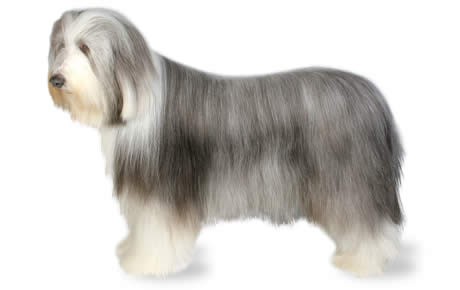Bearded Collie Breed Guide

Breed Group:
Herding Dogs
Get 30% off
Join our Newsletter
Sign Up Today
Bearded Collie Background Info and History
The Bearded Collie, or Beardies as they are affectionately called, was developed in Scotland. It is believed that Beardies are descended from Continental European herders, and were developed as a working sheepdog that could thrive in the cold, wet, and harsh climate of Scotland.
Beardies first appeared in dog shows during Victorian times in England, but official recognition of the breed did not occur until the mid to late 20th century.
Temperament and Personality of Bearded Collies
Beardies are known for their sweet, carefree personality. They are affectionate, outgoing, and friendly towards all. They are also known to be playful and bouncy and get well along well with other pets.
Bearded Collie Training Tips
Beardies are a sensitive breed, so positive reinforcement training is the best course of action. They should be trained and socialized from a young age in order to take advantage of their pleasant disposition. They take well to training and learn commands quickly as they are eager to please.
Exercise Needs of Bearded Collies
Beardies have a background working long days tirelessly in the Scottish Highlands, and so they have a lot of energy. A long daily walk combined with a vigorous play session should take keep your pup happy, and avoid any unwanted acting out.
Bearded Collie Lifespan
Beardies usually live between 12-14 years.
Bearded Collie Breed Popularity
Beardies are relatively popular and currently ranked as the 126th most popular AKC registered breed.
Feeding Requirements of Bearded Collies
Beardies should be fed a high-quality diet with a good mix of healthy proteins and fats, which will keep their coat looking great. Avoid any foods with grain-based fillers. Beardies weigh between 45-55 lbs., so expect to feed the average sized Beardie 2 ¾ to 3 ½ cups of dry food a day, split into two meals.
Bearded Collie Grooming
This breeds distinctive long coat that covers their entire body requires a serious grooming process in order to avoid matting and debris. For Beardies that have a natural length coat, expect to thoroughly brush your pup daily. Many Beardie owners keep their dog’s coats trimmed close to the body, in order to reduce the amount of upkeep required.
Are Bearded Collies Good With Kids?
Beardies are great with children. They have a high energy level, are gentle, and playful, all of which make excellent properties in a dog that is raised with children. As with all dog breeds, play should be supervised with very young children.
Health Problems of Bearded Collies
Hip Dysplasia
Hip dysplasia in dogs occurs due to a loose fit between the femur and pelvis in the rear hip assembly. This loose fit causes the cartilage that pads the bones to wear unevenly, resulting in painful arthritis, bone spurs, and eventually canine lameness in the rear legs.
Hip dysplasia can be diagnosed at a young age by a routine physical examination by a veterinarian. Although Beardies are not highly predisposed towards developing hip dysplasia, it is known to occur in some lines of the breed.
Elbow Dysplasia
Elbow dysplasia in dogs is similar to hip dysplasia in that there is an improper fit between two bones. Elbow dysplasia affects the forelegs, with the radius and ulna (elbow and wrist) fitting together improperly. This fit causes the cartilage to wear unevenly, causing pain and canine lameness.
Elbow dysplasia differs from hip dysplasia in that it presents at a young age, during the growth period from puppy to adolescence. Signs of elbow dysplasia are an uneven gait, lameness following exercise or play, and progressively worsening symptoms.
Progressive Retinal Atrophy (PRA)
PRA is a degenerative disease that affects the photoreceptor cells of the eye. Located in the retina, these photoreceptor cells of are responsible for the Beardie’s ability to receive and perceive light.
The most common early symptom of PRA is a diminished ability to discern objects in low light, such as at dawn or dusk or in a dimly lit room. Over time, the ability to discern objects becomes worse and eventually leads to full loss of vision. PRA is a hereditary condition, so be sure to check with your breeder to determine if it has ever appeared in your pups line.
Hypoadrenocorticism (Addison’s Disease)
Addison’s disease affects the adrenal glands in some breeds, causing decreased hormone production. Decreased hormone production often presents as canine lethargy, diarrhea and vomiting, increased thirst, weight loss, and frequent urination.
While the disease can be fatal if left untreated, in most dogs where Addison’s is diagnosed the condition can be managed. Although Addison’s disease affects a number of dog breeds, Beardies are predisposed towards developing this condition.
Other Resources
National Breed Website: Bearded Collie Club of America
Health Issues Associated with this Breed:
- Allergies
- Elbow Dysplasia
- Hip Dysplasia
- Hypothyroidism
- Inflammation
- Pain
- Persistent Pupillary Membrane (PPM)
- Progressive Retinal Atrophy (PRA)





